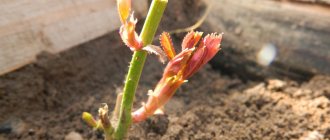History of selection
The variety was bred by David Austin in the UK in 1990. Received as a result of crossing Lilian Austin (1973) and The Squire (1977), which he had previously created. Registered by David Austin Roses as AUSvelvet, patented under the commercial name The Prince.
English roses were used as parent forms: Lilian Austin (AUSli - pictured on the left) and The Squire (AUSquire - on the right)
“The Prince” was awarded various awards and prizes received at international exhibitions: in 1999 in Augusta and Watauga, in 2000 in Rochester, San Antonio, Tampa (USA).
Description of the Prince rose
The English rose "Prince" is famous for its magnificent flowers, changing from a bright red-crimson color to a deep purple-lilac. The variety owes its appearance to the outstanding breeder David Austin, who revived interest in flowers of the ancient type and created a whole collection of modern roses with remontant flowering, strong aroma and high resistance.
The signature rose “Prince” (pictured) is a nostalgic shaped flower with a unique rich purple-lilac color.
According to experts, the variety cannot be called problem-free. It is more suitable for rose growers who already have experience cultivating other varieties of crops. “Prince” will become a wonderful decoration for a small summer cottage or large park areas only if you pay constant attention to it and adhere to the correct agricultural techniques.
What kind of variety is this
The variety was obtained in England in 1840. It was created specifically for cultivation in parks without shelter, as well as in greenhouses for cutting. Author: Graham Thomas. The unique shade of the petals is close to Gallic roses (Rose Gallica) and is not found in modern hybrids.
The park-shrub rose Prince is formed by a low bush - up to 75 cm in height, quite small by today's standards. The shoots are straight and brittle, covered with thorns. The leaf is large, dark green, with a slight gloss.
The flower consists of more than a hundred petals of a complex velvety raspberry-purple-violet hue. As it finally opens, the large (up to 8 cm in diameter) cup-shaped flower bends its petals back.
3-5 buds are formed on each stem.
Flowering is renewable with a large intermediate interval (up to 2.5 months).
For reference: the English name of the variety English Rose The Prince is often translated or misread. On forums and in reviews from gardeners, you can find the names rose The Prince (in fact, the is not readable here) or rose Prince.
Short description
The flower of the bush rose The Prince has a dark red color immediately after it opens. It then takes on a purplish-purple hue. This color is unique and unlike what other varieties of roses look like. This plant has a strong scent of rose oil. The buds are large (diameter is 5-8 centimeters), with many velvety petals, and have a round shape. The petals in the bud are densely arranged, their number can reach 40 pieces.
The flower blooms in the shape of a rosette. When flowering comes to an end, the petals begin to bend slightly downward. The park bush rose Prince has a small bush with a spreading shape. The leaves are dark green with a glossy surface and rarely grow on shoots. There are from 1 to 5 flowers on one shoot.
The height of an adult plant is 60-75 centimeters. English Rose The Prince can bloom more than once during one season.
Appearance
The park-bush rose with the proud name Prince is a low-growing (up to 1.5 m) spreading plant. It has large flowers 6 cm in diameter and dark foliage. Immediately after the buds open, the petals are painted a rich dark red color, but it quickly changes to lilac or purple.
When closed, the buds are round in shape, dark in color, and the petals fit tightly to each other. As they bloom, they bloom and seem to overlap one another. The flowers give off a strong aroma of rose oil.
Prince rose blooming
Flowers are exactly what gardeners take such careful care of the Prince for. It needs to be given maximum attention throughout the active growing season.
- The first wave of flowering occurs in the first half of June. The bush produces a maximum of buds, which last for about 2 weeks.
- Then follows a long break: 2-2.5 months.
- Therefore, the second wave of flowering occurs (usually mid-September).
Alas, in many regions it is not possible to see the second wave due to climatic conditions.
During the entire time the buds are opening, it is necessary to create truly greenhouse conditions for the bush: cover it from rain and sun, regularly feed it, and immediately remove wilted buds.
Description of buds
The flower of the bush rose The Prince has a dark red color immediately after it opens. It then takes on a purplish-purple hue. This color is unique and unlike what other varieties of roses look like. This plant has a strong scent of rose oil. The buds are large (diameter is 5-8 centimeters), with many velvety petals, and have a round shape. The petals in the bud are densely arranged, their number can reach 40 pieces.
The flower blooms in the shape of a rosette. When flowering comes to an end, the petals begin to bend slightly downward. The park bush rose Prince has a small bush with a spreading shape. The leaves are dark green with a glossy surface and rarely grow on shoots. There are from 1 to 5 flowers on one shoot.
The height of an adult plant is 60-75 centimeters. English Rose The Prince can bloom more than once during one season.
Bloom
The bush looks especially impressive at the beginning of summer, when it blooms in the first, most abundant wave. Then during the season there are several waves of repeated flowering, lasting until the autumn frosts in September or October (depending on the climate and agricultural practices).
The flowers are full, double, cup-shaped, flat, and when in bloom they take the form of neat rosettes with a diameter of 5-8 cm. The number of petals can be from 17 to 25, they are dense, velvety, overlapping each other like tiles. The ink-colored buds become deep crimson as they bloom, and then the red hues quickly give way to purple-lilac. According to experts, the velvet-purple color of the Prince’s petals is unique, distinguishing the variety from other modern violet-lilac roses that have a “metallic” tint.
Features of the Prince of Monaco variety
A rose of this variety is rightly called royal - it’s not for nothing that the name contains a reference to the male heir to the throne. Having first bloomed at the beginning of summer, roses delight owners with bright, beautiful and graceful flowers until September. Rose Jubile du Prince de Monaco is resistant to adverse weather conditions, as it tolerates dry summers, rainy autumns, and frosty winters without losing its shape. In addition, the plant is not susceptible to fungal diseases, which often affect other varieties of roses, and is not afraid of garden pests. The bush is of medium size, but does not grow throughout the entire area.
Below is a brief description of the plant:
- The height of the bush is 70-80 centimeters.
- Typically the flower diameter is 8-10 centimeters, but flowers with a diameter of 12 centimeters have been recorded.
- The plant has a rather weak aroma, so it does not cause headaches and does not cause allergies.
- The Prince of Monaco rose blooms for a very long time - from the beginning of June until the first frost.
- On average, each flower has 30-40 petals, which hide yellow stamens in the middle.
- According to the international climate map, the plant can be planted in zones 3-6.
- Flowers are resistant to frost and rain.
Additional Information! In the CIS countries, the rose Jubile du Prince de Monaco has gained such popularity that on Valentine's Day (February 14) up to 3 million flowers of this variety are sold every year.
Flowers easily withstand frosts down to -20 degrees and rainy periods. If you plant the bush at the end of April - beginning of May, the roses will delight the owner with blooming buds the very next season.
Hybrid roses Prince de Monaco
Main characteristics
We propose to consider the most significant features of the variety in the table:
| Parameter | Characteristic |
| Culture | Rose (Rosa L.) |
| Variety | “The Prince” (The Prince, AUSvelvet, “The Prince”) |
| Garden group | Modern Shrub (MS), English Roses |
| Form | Bush |
| Life cycle | perennial |
| Purpose | Decorative, cutting |
| Reproduction | Vegetative (by cuttings) |
| Dimensions of the bush (height/width) | 75-120 / 60-120 cm |
| Flowering type | Reblooming |
| Flowering period | June – September |
| Type of flower | Terry |
| Number of petals | On average 17-25 pcs. |
| Flower diameter | 5-8 cm |
| Petal coloring | Dark red, purple-lilac |
| Disease resistance | Average |
| Frost resistance | Up to −23.3 ℃ |
| Registration in the State Register of the Russian Federation | Absent |
| Originator/patent holder, year of introduction | David Austin Roses (UK), 1990 |
Peculiarities
Description
Park rose English Prince (The Prince) - flowers of magnificent color, at the beginning of flowering a rich dark red color, then changing to purple. Very strong scent of rose oil. The height of the bush is about 60-75 cm. The foliage is dark and sparse.
| Bush height: | 60-75 cm |
| Flower: | purple, velvet |
| Flower size: | 5-8 cm |
| Number of petals: | 35-40 |
| Number of flowers per stem: | 1-5 pcs |
| Aroma: | easy |
| Bloom: | repeated |
| Frost resistance: | USDA zone 5 (see Climate Zones) |
| Disease resistance: | average |
| Rain resistance: | average |
Planting and care
Roses should be planted in warm, sunny places where there are no cold winds. Roses prefer moist and well-drained soils, with an acid-base reaction of 5.6-7.3 pH. The planting hole should correspond to the clod of earth, so that the roots are located freely. The depth must be at least 50 cm, since it is necessary to make drainage from sand or gravel. Stagnation of water should not be allowed. The following soil mixture is suitable for roses: manure (3 parts), fertile soil layer (2 parts), sand (2 parts) and peat (1 part). The best time for planting is the beginning of May, by which time the soil has already warmed up.
Before planting, it is better to keep the seedlings in water, especially if the root system is open. 4-6 hours is enough. If the roots have damaged shoots, it is advisable to remove them. It is better to shorten the shoots, cut off the weak ones, leaving the strong and medium ones. This will promote faster growth.
Roses need to be regularly fed, weeded and watered; the choice of complex fertilizers is quite large. Typically, fertilizing is carried out in spring and mid-summer. Water abundantly, usually once a week. In the spring, roses are pruned, even before the buds awaken.
It is advisable to cover roses for the winter. To do this, it is usually enough to fill the bush with peat, 20 cm high, and level the ground in the spring.
Climatic conditions
The variety tolerates frosts down to -23 degrees Celsius; in regions with colder winters, it is better to cover the bush for the winter.
Advantages and disadvantages
Valuable advantages of this rose:
- A strong and long-lasting classic rose scent.
- Unique petal color.
- Suitable for growing in open ground and in a greenhouse.
- Frost resistance - up to -23 °C.
- Not prone to shedding petals.
- Propagates well by cuttings.
There are quite a few shortcomings, which indicates more of the shrub’s demanding care:
- It does not tolerate strong winds, which break branches and even buds. It should be planted in a protected place.
- The English Prince rose does not tolerate rain on its buds, whose appearance very quickly deteriorates because of this.
- Prefers partial shade; in the hot sun the flowers burn and dry out.
- Average resistance to powdery mildew and black spot.
Rose Prince should be planted in the shade of large trees, not in the foreground of mixborders. The amazingly beautiful flowers are very delicate and do not tolerate rain, direct sun, or strong wind. If you want to get beautiful shoots for cutting, it is recommended to plant the bush in a greenhouse or conservatory.
Rose English Prince has the following advantages:
- beautiful flowers and great aroma;
- withstands winter conditions well.
The following disadvantages should be noted:
- The plant needs quality care. It takes considerable effort from the grower to grow this magnificent rose.
- Resistance to diseases and attacks by insect pests is at a moderate level.
- Does not tolerate precipitation well.
The plant does not tolerate high humidity.
Advantages and disadvantages of the variety
Rose Jubilee of the Prince of Monaco (Jubile du Prince de Monaco) - what kind of variety is it
Rose English Prince has the following advantages:
- beautiful flowers and great aroma;
- withstands winter conditions well.
The following disadvantages should be noted:
- The plant needs quality care. It takes considerable effort from the grower to grow this magnificent rose.
- Resistance to diseases and attacks by insect pests is at a moderate level.
- Does not tolerate precipitation well.
The plant does not tolerate high humidity.
Reproduction methods
When propagating rose bushes, cuttings or layering are used. Seeds are not used due to the fact that the variety is a hybrid and the qualities of the parent plants will not be inherited.
To obtain seedlings, you need to start working with the plant at the beginning of the growing season. At the same time, rose seedlings will have enough time for their rooting and development.
For cuttings, cut off a part of the shoot 15-20 centimeters long. It is necessary that there are at least three buds on it. The cuttings are planted in the substrate and provided with moisture and warmth. When they form roots and leaves begin to grow, they can be planted in a permanent place.
To get layering, you need to select a shoot and sprinkle it with earth in one place. It is necessary to water this area of the shoot regularly. When the roots begin to grow, the branch needs to be cut off from the side of the parent plant and planted in a new place.
By growing Prince roses, flower growers receive beautiful and unique flowers, which with their beauty pay off the work they put in.
With the help of green strong shoots you can carry out cuttings. The Prince bush rose does not propagate by seeds, since you can expect flowers from such a plant only 3-4 years later if it is successful.
The beginning of June and the second half of September are suitable for cutting planting material.
Cuttings
In the fall, during pruning, healthy woody shoots more than 10 cm long are selected. They are placed in a box with sand, where they will lie at a temperature of 0 to +4 ° C until spring. The sand is periodically slightly moistened as it dries. In the spring, in mid-May, cuttings are buried in open ground and covered with a greenhouse.
Attention! If successful, by the end of August there will be young seedlings under cover ready for transplanting.
In the first half of June, green cuttings are harvested. The tops of the shoots are cut off, removing the bud to the first bud. The optimal cutting length is 10-12 cm with 3 pairs of buds. The lower leaves are removed and the upper ones are shortened by half. Then the finished cuttings are planted in the same way in the prepared place, covered with a greenhouse. At the end of August they are dug up and transplanted into pots, which are kept cool (about 0 ° C) until next spring.
Climbing varieties
vertical gardening
In any case, the rose will become a real decoration of this structure. Decorative design of a garden plot is now impossible without such flowers. This type is incredibly popular among landscape designers.
Climbing bush roses can be grouped into three types:
- Curly. Such bushes reach a length of about 15 meters.
- Climbing. This rose grows up to a maximum of five meters.
- Semi-climbing. The height of such a bush will be from 1.5 to 3 meters.
The flowering period of such bushes is quite long and can reach 170 days. And all thanks to the fact that the plant actively forms new shoots on which buds appear and bloom as they mature.
Excelsa
active growth
This variety is extremely hardy to cold climates and will survive even the harshest winter. The flowers are quite small, crimson in color, with a velvety structure. The bush blooms very profusely for about a month, but the leaves remain green until late autumn.
Recommendations for agricultural technology
The plant needs constant attention, loves good conditions and proper care. “Prince” is moderately resistant to fungal diseases: with high humidity due to too intense watering on the leaves or prolonged rains, as well as with insufficient air circulation, it can be affected by black spot and powdery mildew.
Therefore, when choosing a place for planting, it is recommended to avoid lowlands where water accumulates. Affected bushes lose their attractiveness and have an unkempt appearance. In such cases, damaged leaves and shoots are removed, and the bush is treated with chemicals (fungicides) or folk remedies to combat these diseases.
Important! Spraying is carried out in dry weather in the morning or afternoon, no later than six hours before the appearance of evening dew.
The variety prefers open places, well lit by the sun, protected from strong winds and drafts.
It is better to place seedlings in areas with loose, fertile soil that has neutral or low acidity, good air permeability and high-quality drainage.
Experts advise doing radical pruning in the spring, forming rounded bushes 50-70 cm high. After this, the “tender” shoots become stronger and better keep the flowers from drooping.
Watering is carried out at the root 1-2 times a week, depending on weather conditions. Adult plants require regular feeding in March-April and June-July, that is, in the spring to stimulate growth (nitrogen) and in the summer to maintain abundant flowering (potassium-phosphorus).
In the fall, it is recommended to apply phosphorus fertilizers to prepare for the dormant period.
The bush is able to withstand frosts down to −20… −24 ℃. In regions with a mild climate, roses do not need to be covered for the winter. In the northern regions, in the fall, when a stable sub-zero temperature has established, the leaves and remaining inflorescences are removed from the bush, then its base is hilled up and the root part is covered with straw, a special frame is built and wrapped in non-woven material.
The bright red-purple “Prince” from David Austin goes well with the delicate two-color “Prince of Monaco” bred by the French nursery Meilhan.
Flower growers who grow The Prince roses talk about the varieties and point out a number of serious disadvantages:
- tendency to be affected by black spot and powdery mildew, especially in unfavorable conditions (high humidity and excessive thickening of the bush);
- the need for shelter in regions with cold winters;
- weakness of thin flower shoots;
- low resistance to rain and sun.
Growing a flower
Rose Black Prince is a culture of active agricultural technology, so caring for it cannot be called too simple. Planting material should be selected grafted, Dutch or Russian made. It is preferable to plant roses in open ground in mid-May, when the threat of frost has passed and the soil has warmed up sufficiently.
The ideal place for growing Black Prince is a flat, draft-free area with loose, fertile soil, low groundwater and good drainage.
Note! It is better to plant the rose in partial shade; direct rays of the sun are permissible only in the morning and evening. The plant prefers nutritious, slightly acidic soil, pH 6-6.5
Adding peat or manure will help increase acidity, and lime or ash will help reduce it.
The plant prefers nutritious, slightly acidic soil, pH 6-6.5. Adding peat or manure will help increase acidity, and lime or ash will help reduce it.
To properly plant a rose, you need to take the following steps:
- Dig a planting hole with a depth and diameter of at least 60 cm.
- A 10 cm thick layer of drainage is laid at the bottom of the hole. It can be expanded clay, pebbles, shell rock.
- A 20 cm thick layer of nutrient soil mixed with 20 g of superphosphate and 20 g of potassium sulfate is poured over the drainage.
- The seedling is placed in the prepared hole.
- The root system is covered with soil.
- The seedling is watered abundantly with water at room temperature.
- The soil around the seedling is mulched with peat, bark, and sawdust.
Important! In order for the climbing rose to produce the maximum number of flowering shoots, when planting, the root collar is buried 3-5 cm
Planting a rose bush is a responsible undertaking
Planting a rose Prince
The culture does not have specific requirements for planting and care. Before planting, you should familiarize yourself with the following features of growing the Ze Prince rose:
- The place where the bush grows should be sunny, the optimal length of daylight is 16 hours. The plant can grow in partial shade, but lush and long-lasting flowering cannot be achieved.
- It is recommended that the landing site be located on a hill or plain, but not in a depression. If this rule is neglected, excess moisture will accumulate in the growth area, which will lead to rotting of the root system and the development of fungal diseases. And also cold air currents stagnate there.
- The area should be well ventilated, but at the same time there should be no gusts of wind or drafts.
The best time for planting is spring (April or May). To ensure lush flowering and healthy bushes, you must strictly follow all the rules of care; they also cannot be called specific. Caring for the plant comes down to regular but moderate watering, do not allow the soil to dry out, regular application of mineral and organic fertilizers, as well as loosening to remove weeds and cover for the winter.
Important! Watering should be carried out strictly at the root; if moisture gets on the root collar, this can lead to disease and inhibit the growth of the bush.
In what form is planting carried out?
To plant the crop, you need to use ready-made seedlings. In this case, it is necessary to carefully consider the choice of planting material. He must be vaccinated and of Russian or Dutch origin.
Deadlines
With the onset of the third ten days of April, it is worth starting the search for a Prince rose seedling. If you are lucky, you can plant it immediately, but otherwise you will have to wait until mid-September.
Selecting a location
For planting, it is recommended to choose an area that is well lit by the sun. The optimal length of daylight for the Prince rose is 16 hours. If there is slight shade on the site, the plant will be able to grow normally in such conditions, but flowering will not be as lush and long-lasting as in bright sunlight.
Important! It is not recommended to plant a rose in a cavity. It is better if a flat or elevated surface is chosen for this. This is important to ensure that excess moisture does not accumulate, which can contribute to root rot.
The best place for this rose will be an area under tall trees or shrubs. They will be able to protect the Prince from the wind and hot sun, and during rain they will cover him from the pounding jets.
Important! Like other park roses, this one should not be thickened - any other bushes should retreat at least 50 cm.
Selection of planting material
Park rose Prince is a hybrid, so propagation by seeds is not carried out. This is due to the fact that with this method of growing, seedlings will not inherit the qualities of the parent plants.
For your information! However, it is allowed to use seeds that were purchased from specialized nurseries. In the first generation, plants grown with their help will show all the advantages of this beautiful variety.
When independently propagating bushes, seedlings obtained by cuttings or layering are used.
How to prepare the soil
If planting is carried out in the spring, then the site is prepared in the fall by digging up the soil and mixing it with a large amount of humus or humus. They do the same when planting in the fall, preparing the bed a month in advance.
Rose Prince prefers slightly acidic soil with pH=5.5-6.5. Black soil is perfect, but more loosening ingredients need to be added to the loam: peat, river sand, sawdust (for autumn digging).
Caring for the Prince rose
How attentively the gardener approaches the issue of care directly determines whether he will be able to see the extraordinary beauty of the Prince this year.
Careful care ensures that the rose will delight the grower with luxurious blooms. The following outlines the basic rules for growing Prince roses.
Watering rules
Watering is carried out throughout the warm season. As soon as the soil dries 5 cm deep, you need to pour 10 liters of water under each bush. Sprinkling is not recommended during flowering, but in the interim it is done in the hottest months in the early morning or after sunset.
Top dressing
In total, up to 7 feedings are carried out per season:
- The first consists of ammonium nitrate in the amount of 20 g per 1 m².
- The subsequent ones alternate: organic (solutions of mullein, humate) and mineral (potassium and phosphorus in a 3:1 ratio in an amount of up to 30 g per 1 m²).
Weeding
Weeding should be done regularly. It is necessary to loosen the soil around the plant and remove weeds.
Pruning and replanting
Shoots are pruned in spring, summer and autumn. Their goal is to form a strong and symmetrical bush with a large number of young shoots.
Once every 3 years, rejuvenation is practiced, when the shoots are shortened in the spring, leaving no more than 3-4 buds on each. In the first year, all buds are removed to build up skeletal branches. Autumn pruning prepares the bush for wintering, so all unripe branches and buds are removed.
The Prince is a rose that does not like transplants. The procedure is carried out only in case of emergency: in the spring before the buds open, or in the fall in the first half of September.
During and after flowering
Luxurious rose bloom occurs if all care rules are followed. If they are not provided, the flower may become depressed and sick.
Rose Prince finishes flowering no later than the end of July. After this, it must be prepared for the onset of winter. The dormant period continues until the end of winter.
During flowering, the plant does not require additional care. After this, a second feeding is carried out, which will support the strength of the plant during the winter period.
Features of wintering
For the winter, in regions where the winter air temperature does not drop below -10°C, you can do without shelters. In the zone of winter minimums down to -23°C, the bush is hilled with a thick layer of peat, on top of which spruce branches are laid.
Important! In more northern areas, the Prince rose is dug up for the winter and kept in boxes with sand. Basements are chosen for storage, maintaining a temperature of about 0°C.
What to do if it doesn't bloom
Reasons for the lack of flowers:
- Lack of nutrients in the soil: urgent fertilizing is required. The sign is sluggish and skinny shoots.
- Incorrect pruning, the bush has grown, suffocating itself with extra weak shoots.
- Lack of lighting. The rose feels good in partial shade, but it needs sunlight 4 hours a day (preferably in the morning).
- The foliage is affected by a fungal disease or damaged by pests; treatment with fungicides and insecticides is necessary.
If this happened during the first year of the rose's life, then this is normal. Typically, flowering begins within the next year.
The plant needs good lighting. If this has not been ensured, then the rose may not begin to bloom.
If the pruning was too severe, it could require the bush to spend a lot of effort on renewing shoots. This procedure must be carried out carefully and in accordance with the rules.
For your information! If the rules of care are violated, problems with flowering are a natural result.
Diseases and pests
The greatest dangers for this variety of roses are black spot and powdery mildew. If infection occurs, the affected leaves and shoots will need to be removed and the plant sprayed with specialized preparations.
The greatest damage to the plant can be caused by:
- Powdery mildew. All affected parts are cut out and burned, and the rose is treated with an ash solution infused for 5 days (1 glass per 10 liters of water).
- Black spot. Spring treatment with Fitosporin in 2 stages will help: first with a solution of 7 ml per 1 liter of water, and after a week - 3.5 ml per 1 liter of water.
- Rust. To prevent this, already affected bushes are sprayed with a solution of Bordeaux mixture in 2-3 doses with an interval of 7-10 days.
- Aphid. Sprayed with Spark, Bison, Commander.
- Leaf roller. The drug Molniya helps.
- Spider mite. Spray with Iskra-M solution in two approaches with an interval of 10-12 days.











